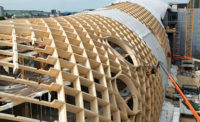Employing what they call a "research-and-diagram-based process," David Leven and Stella Betts, of New York City'based Leven Betts Studio, have been creating environments that are inventive, spare, and elegant for the past decade. Their method involves scrutiny of site, program, and material, to create an organizational framework and physical structure. "The process is not always so legible in the final product," says Betts. However, it provides the basis for a project-specific "patterning system and a formal language," adds Leven.

Though such talk might sound like the stuff of paper architecture, the partners are well-grounded in the realities of construction. Leven's resume includes a stint in a metal fabrication shop, while Betts spent two years as a project manager at a construction firm. "Out of graduate school, my agenda was to understand how things were put together," she says.

The firm's early commissions were primarily for furniture, with the husband-and-wife team fabricating many of the pieces. On occasion, the pair will still perform "soft" construction tasks. In a house completed last year in Columbia County, New York, they installed metalwork and assembled polycarbonate walls. "We are not really set up for design-build, but once in a while we have to get our hands on something," says Leven. Leven and Betts say that the design of the house was inspired by the surrounding landscape. They used the crop lines created by cultivation of the land to generate the elongated footprint of house, patio, and garage and guide their selection of materials, such as the corrugated-metal exterior sheathing. Similarly, in their scheme for a Manhattan gallery, the architects took their cues from the irregular geometry of an existing beam-and-column structure, creating a glowing, gently zigzagging suspended ceiling of aluminum flat bar and translucent acrylic [RECORD, August 2006, page 175].
In addition to other realized projects that include a furniture showroom [RECORD, February 2004, page 160] and a small printing plant, the studio designed the current Piranesi show at New York City's Cooper Hewitt. The installation has received acclaim for its sensitivity to the exhibition's content and the architecture of the museum's late-19th-century home. The partners are now trying to turn the corner into institutional work, recently completing a proposal for an affordable-housing complex on Long Island featuring 45 duplex apartments arranged around a common green.
One theme that has long fascinated Betts and Leven is the relationship between the car and the city. In 2003, the firm won a Chicago Architecture Club competition for design of a 1,000-car automated parking garage. The team proposed spanning that city's Kennedy Expressway with a glazed structure that would also provide a caf', a vertical garden, and a route for pedestrians and cyclists to cross the multilane highway. Since winning the competition, the couple has included automated parking facilities in several other proposals, as both revenue generator and public amenity. When Leven Betts gets the opportunity to translate these ideas into bricks and mortar'or more likely polycarbonate, glass, concrete, and steel'the urban environment should certainly benefit.






